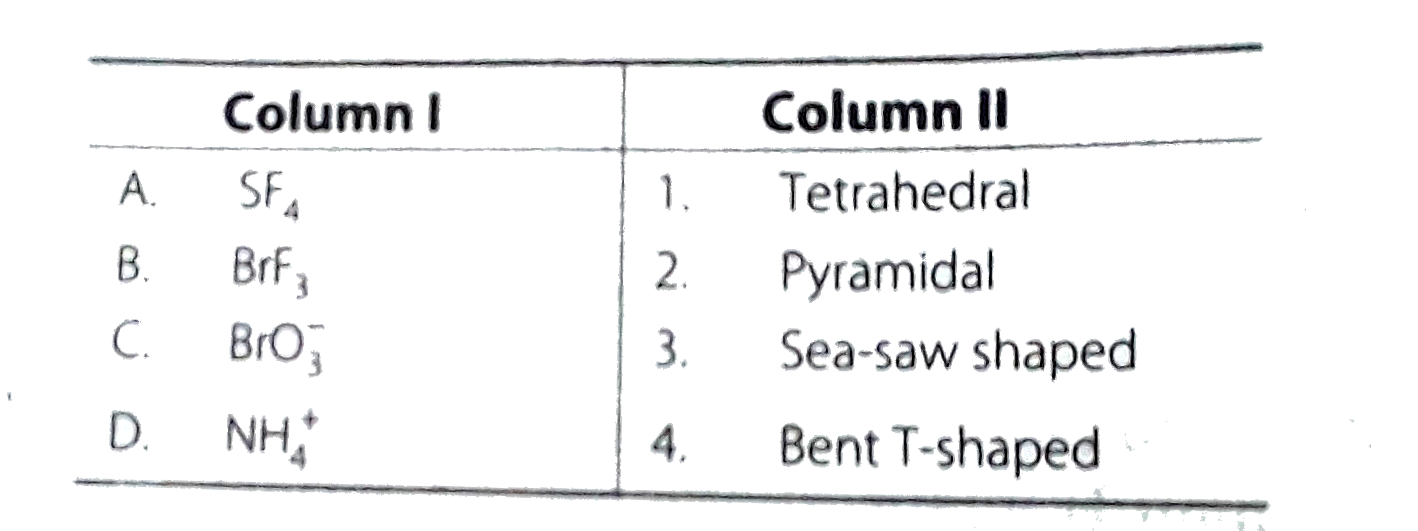Match the order given in column (I) with the property(les) in column (II).
The correct Answer is:A-p,q ; B-q ; C-r ; D-s,t
(A)Down the group the decrease in the lattice energy is more as compared to that of hydration energy with increase in size of cations.So the solubility order is correct.Similarly the thermal stability of the oxo-salts increases with increase in metallic character.So the thermal stability order is correct.
(B)The correct order of solubility is as in this case decrease in hydration energy is more as compared to that of lattice energy.
The orde of thermal stability is correct, as down the group metallic character increases and thus the thermal stability of oxo-salts increases.
(C )Down the group strength of metallic bond decreases Due to this there occurs a decrease in close packing of atoms in crystal lattice from Li to Cs and thus softness increase donw the group.
(D)hydration energy So BegtMggtCa is correct order.
Ionisation energy So BegtMggtCa is correct order.
Topper's Solved these Questions
Similar Questions
Match the increasing orders given in column I with the property given in column II
Column-IColumn-II(A)Na+<F−<O2−<N3−(p)Electronegativity(B)Li+<Na+<K+<Rb+<Cs+(q)Nuclear charge(C)O S F Cl(r)Size(D)Cl−<K+<Ca2+<Sc2+(s)Electron affinity(t)Ionisation energy
View SolutionMatch the increasing orders given in column I with the property given in column II
Column-IColumn-II(A)Na+<F−<O2−<N3−(p)Electronegativity(B)Li+<Na+<K+<Rb+<Cs+(q)Nuclear charge(C)OltSltFltCl(r)Size(D)Cl−<K+<Ca2+<Sc2+(s)Electron affinity(t)Ionisation energy
View Solution
Knowledge Check
Match the elements given in column (I) with the most appropriat expected values given in column II
Column IColumn IIElementElectronegative valuesA.F(p)3.5B.O(q)3.0C.N(r)4.0D.C(s)2.5AA(r ), B(p),C(q),D(s)BA(s),B(q),C(r ),D(p)CA(p),B(q),C(r ),D(s)DA(r ),B(q), C(p),D(s)Match the species given in Column I with the shape given in Column II and mark the correct option.
 AA(3)B(2)C(1)D(4)BA(3)B(4)C(2)D(1)CA(1)B(2)C(3)D(4)DA(1)B(4)C(3)D(2)
AA(3)B(2)C(1)D(4)BA(3)B(4)C(2)D(1)CA(1)B(2)C(3)D(4)DA(1)B(4)C(3)D(2)
Match the particular given in column (I) with the compound in column (II)
Column IColumn II(A)Solvary process(p)NaCl(B)EvolveCO2on heating(q)Na2O3(C)Aqueous solution is neutral towards litmus(r)NaHCO3(D)Oxone(s)Na2CO3(t)CaCl2
View SolutionMatch the conversions in Column I with the type(s) of reaction(s) given in Column II.
Column IColumnIIA.PbS→PbOp.RoastingB.CaCo3→CaOq.CalcinationC.ZnS→Znr.Carbon reductionD.Cu2S→Cus.Self-reduction
View SolutionMatch the elements given in column (I) with the most appropriate expected values given in column (II)
Column IColumn IIElementElectronegative valuesA.F(p)3.5B.O(q)3.0C.N(r)4.0D.C(s)2.5
View SolutionThe solutions of two compounds listed in column-I when taken in molecular proportions give coordination compounds on evaporation, Match these compounds with their properties listed in column-II.
Column-IColumn-II(A)Fe(CN)2.4KCN(p)Coordination number of central metal ion is six(B)CuSO4.4NH3(q)Coordination number of central metal ion is four(C)3NaF.AIF3(r)Coordination number of central metal ion is two (C)3NaF.AIF3(s)Oxidation state of central metal ion is +2(t)Overall charge on complex ion is+2
View SolutionMatch the species in Column I with the bond order in Column II
Column I Column II (i)NO (a)1.5(ii)CO (b)2.0(iii)O−2 (c)2.5(iv)O2 (d)3.0
View SolutionMatch the term given in column I with its description in Column II
Column I Column II(a)Path function (p)Heat(b)State function (q)Internal energy (c)Intensive property(r)Entropy(d)Extensive property (s)Specific heat
View Solution
